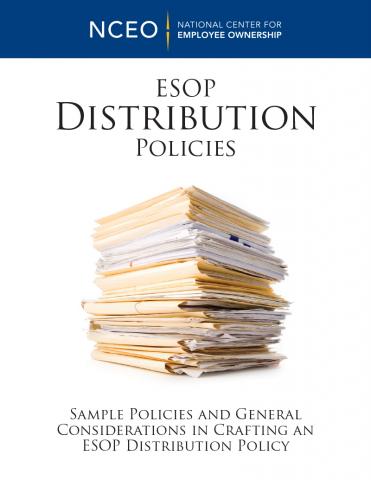Description
Until 2010, the IRS reviewed ESOP plan documents simply to assure that the maximum payout terms were specified. Now, however, the IRS wants to see the actual distribution policy, whether in the plan or as a separate document. Many ESOP companies either do not have such a policy or have only a rudimentary plan. ESOPs must now submit a distribution policy either for a new letter of determination or in the five-year cycle for resubmission of plans. This issue brief provides sample language and detailed commentary to help you create such a policy. In the first part of this brief, a chapter by Rebecca Hoffman and Cindy Prodoehl from our book Administrative Issues for ESOP Companies explains why you need an ESOP distribution policy and the major elements of a policy. In the second part, we provide three sample distribution policies and commentary on the choices made in each policy. The language is taken from actual distribution policies provided by NCEO members. In the third and final part, we discuss issues the sample policies do not address but you may want to consider.
Product Details
Table of Contents
Introduction 1
How to Use This Issue Brief
Part I: "Do You Need an ESOP Distribution Policy?" by Rebecca Hoffman and Cindy Prodoehl
Part II: Sample Language for ESOP Distribution Policies
Example 1: ABC Company Distribution Policy
Example 2: DEF Company Distribution Policy
Example 3: XYZ Company Distribution Policy
Part III: Appendix: Additional Policy Considerations and Language
Suggested Rebalancing Language
Other Topics to Consider
Excerpts
From Part II, "Example 1: ABC Company Distribution Policy"
(a) Vested account balances with a value of $10,000 or less will be distributed in a lump sum in the year following the year of separation.
The company is going beyond the requirements of the law on this—it could wait until the plan year that is five years after the end of the plan year in which the employee terminates but the company wants to get these smaller account balances off its books earlier. The dollar amount here, of course, could be any number. Note that if the dollar threshold were increased due to liquidity concerns, this would change the form of payment for affected participants but would not delay the timing of benefit commencement.
(b) Vested account balances with a value exceeding $10,000 will be distributed in approximately equal annual installments over a period of not more than five years, commencing in the Plan Year following the year of separation. The annual installments will not be less than $10,000 each, regardless of the size of the account. Participants will be given the option of taking a lump-sum distribution in the fifth year following the year of separation or, if earlier, the year in which the account would have been reduced to zero if it had been distributed in annual installments of $10,000.
Here too the distributions are earlier than required in that they start in the plan year following separation, instead of the maximum six years after separation occurs. Furthermore, by stipulating the amount distributed will be no less than $10,000, the company avoids having small remaining balances.
